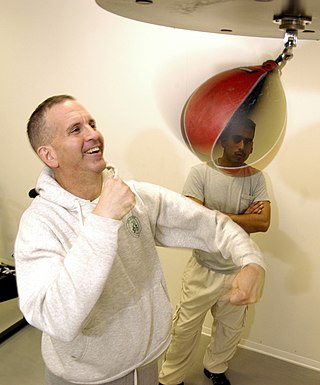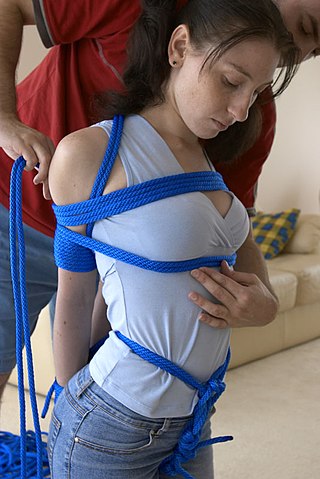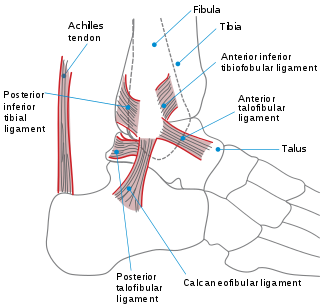
Boxing training is the training method that boxers use in order to get more fit for their sport.

A paddle is a handheld tool with an elongated handle and a flat, widened distal end, used as a lever to apply force onto the bladed end. It most commonly describes a completely handheld tool used to propel a human-powered watercraft by pushing water in a direction opposite to the direction of travel. It is different to an oar in that the latter is attached to the watercraft via a fulcrum.
In human anatomy, the extensor carpi ulnaris is a skeletal muscle located on the ulnar side of the forearm. The extensor carpi ulnaris acts to extend and adduct at the carpus/wrist from anatomical position.

A bracelet is an article of jewellery that is worn around the wrist. Bracelets may serve different uses, such as being worn as an ornament. When worn as ornaments, bracelets may have a supportive function to hold other items of decoration, such as charms. Medical and identity information are marked on some bracelets, such as allergy bracelets, hospital patient-identification tags, and bracelet tags for newborn babies. Bracelets may be worn to signify a certain phenomenon, such as breast cancer awareness, or for religious/cultural purposes.

De Quervain syndrome occurs when two tendons that control movement of the thumb become constricted by their tendon sheath in the wrist. This results in pain and tenderness on the thumb side of the wrist. Radial abduction of the thumb is painful. On occasion, there is uneven movement or triggering of the thumb with radial abduction. Symptoms can come on gradually or be noted suddenly.

A ganglion cyst is a fluid-filled bump associated with a joint or tendon sheath. It most often occurs at the back of the wrist, followed by the front of the wrist.

A sprain is a soft tissue injury of the ligaments within a joint, often caused by a sudden movement abruptly forcing the joint to exceed its functional range of motion. Ligaments are tough, inelastic fibers made of collagen that connect two or more bones to form a joint and are important for joint stability and proprioception, which is the body's sense of limb position and movement. Sprains may be mild, moderate, or severe, with the latter two classes involving some degree of tearing of the ligament. Sprains can occur at any joint but most commonly occur in the ankle, knee, or wrist. An equivalent injury to a muscle or tendon is known as a strain.

Bondage in BDSM, is the activity of tying or restraining people using equipment such as chains, cuffs, or collars for mutual erotic pleasure. According to the Kinsey Institute, 12% of females and 22% of males respond erotically to BDSM.

A splint is defined as "a rigid or flexible device that maintains in position a displaced or movable part; also used to keep in place and protect an injured part" or as "a rigid or flexible material used to protect, immobilize, or restrict motion in a part". Splints can be used for injuries that are not severe enough to immobilize the entire injured structure of the body. For instance, a splint can be used for certain fractures, soft tissue sprains, tendon injuries, or injuries awaiting orthopedic treatment. A splint may be static, not allowing motion, or dynamic, allowing controlled motion. Splints can also be used to relieve pain in damaged joints. Splints are quick and easy to apply and do not require a plastering technique. Splints are often made out of some kind of flexible material and a firm pole-like structure for stability. They often buckle or Velcro together.

Tennis elbow, also known as lateral epicondylitis or enthesopathy of the extensor carpi radialis origin, is an enthesopathy of the origin of the extensor carpi radialis brevis on the lateral epicondyle. The outer part of the elbow becomes painful and tender. The pain may also extend into the back of the forearm. Onset of symptoms is generally gradual although they can seem sudden and be misinterpreted as an injury. Golfer's elbow is a similar condition that affects the inside of the elbow.
A soft tissue injury is the damage of muscles, ligaments and tendons throughout the body. Common soft tissue injuries usually occur from a sprain, strain, a one-off blow resulting in a contusion or overuse of a particular part of the body. Soft tissue injuries can result in pain, swelling, bruising and loss of function.

A squat is a strength exercise in which the trainee lowers their hips from a standing position and then stands back up. During the descent, the hip and knee joints flex while the ankle joint dorsiflexes; conversely the hip and knee joints extend and the ankle joint plantarflexes when standing up. Squats also help the hip muscles.

Wristbands are encircling strips worn on the wrist or lower forearm. The term may refer to a bracelet-like band, similar to that of a wristwatch, to the cuff or other part of a sleeve that covers the wrist, or decorative or functional bands worn on the wrist for many different reasons. Wristbands are often worn and used similarly to event passes such as lanyards to information or allow people entry to events. These wristbands are made from loops of plastic that are placed around the wrist and are used for identification purposes.

Sports equipment, sporting equipment, also called sporting goods, are the tools, materials, apparel, and gear used to compete in a sport and varies depending on the sport. The equipment ranges from balls, nets, and protective gear like helmets. Sporting equipment can be used as protective gear or a tool used to help the athletes play the sport. Over time, sporting equipment has evolved because sports have started to require more protective gear to prevent injuries. Sporting equipment may be found in any department store or specific sporting equipment shops.

A back brace is a device designed to limit the motion of the spine in cases of bone fracture or in post-operative spinal fusiona, as well as a preventative measure against some progressive conditions or to correct patient posture.

A sprained ankle is an injury where sprain occurs on one or more ligaments of the ankle. It is the most commonly occurring injury in sports, mainly in ball sports such as basketball, volleyball, football, and tennis.

Wrist pain or open wrist is a type of syndrome that prevents the patient using their hand due to a painful wrist. The pain may be sharp, sometimes steadily increasing after trying to apply force. Typically pain is caused after exerting too strong a demand on the wrist, as is the case with weight lifters, athletes in general, or with any weight-bearing activity to the wrist.

Orthotics is a medical specialty that focuses on the design and application of orthoses, sometimes known as braces or calipers. An orthosis is "an externally applied device used to influence the structural and functional characteristics of the neuromuscular and skeletal systems." Orthotists are professionals who specialize in designing these braces.

An ankle brace is a garment that is worn around the ankle to protect it or for immobilization while allowing it to heal from sprains and other minor injuries. Ankle braces are used to immobilize the joint while providing heat and compression to the bones. They are common in injury rehabilitation processes that affect the ankle, being made of rigid fabric such nylon and neoprene that allow limited mobility of the foot and conform to the ankle by a hook and loop fastener. To ensure its fixation, the foot portion may include metal pieces. In severe cases, they incorporate metallic plates to better immobilize the joint. Ankle braces may not be adequate in treating more severe sprains and ankle injuries.






















